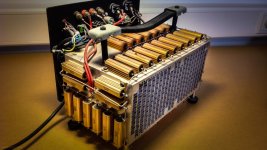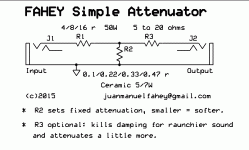First of all, hello to everybody.
A new idea came to mind, as I am making an EL86 Push-Pull amp that puts out about 15W normal use and about 20W peak power, it is really loud as I wanted it to be, but i want to get "that mean tone" in my bedroom so i go for a good ole vintage resistor attenuator but I really don't know what do I need...
I was guessing something that looks vintage, feels vintage and uses resistors and sounds good, so what do I actually need? How do I make it, and will it sound good, can I add some passive tone circuitry...
Thanks for helping in forward.
A new idea came to mind, as I am making an EL86 Push-Pull amp that puts out about 15W normal use and about 20W peak power, it is really loud as I wanted it to be, but i want to get "that mean tone" in my bedroom so i go for a good ole vintage resistor attenuator but I really don't know what do I need...
I was guessing something that looks vintage, feels vintage and uses resistors and sounds good, so what do I actually need? How do I make it, and will it sound good, can I add some passive tone circuitry...
Thanks for helping in forward.
Do you mean you'd like to diy one of these?
Notice the fan cooling. The resistors have to dissipate a lot of heat and will be of the heatsinked variety.
Safety considerations are paramount if you intend to design one of these!
Harley Benton PA-100 Power Attenuator – Thomann UK
Notice the fan cooling. The resistors have to dissipate a lot of heat and will be of the heatsinked variety.
Safety considerations are paramount if you intend to design one of these!
Harley Benton PA-100 Power Attenuator – Thomann UK
IDK if this is kosher for vintage amps folks but You could easily fit and wire a high power L-pad in between the amplifier output tap and the speaker. A drill and soldering iron maybe all that's needed. I have not used this part brand but the sound should not be a major factor. The snarl or shout effect maybe due to other factors. Certain untreated paper cone drivers are known to sound different when driven loud. EDIT also because insertion loss of a added l-pad the lower tones could be more uplifted presence. good or bad? IMO it might be good so try it out.
Last edited:
I have not used this part brand but the sound should not be a major factor.
I'm sorry infinia, but this L-pad is really only suitable as a hi-fi tweeter level control, and not as a guitar speaker attentuator. It could not handle 20W of continuous guitar power without burning out.
This is why I stress the safety considerations and to beware the simple circuits that can be seen on the internet.
I would simply buy the Harley-Benton PA-100 and be confident that it has been designed with safety in mind.
No worries im sure the smell would be available to conclude any impending testing failure.
says 50W RMS which is a fairly precise definition. Yes it's reasonable that using 2 to 1 derating may not be enough for extended 'lab type tests' over the full audio spectrum .
says 50W RMS which is a fairly precise definition. Yes it's reasonable that using 2 to 1 derating may not be enough for extended 'lab type tests' over the full audio spectrum .
Last edited:
Last edited:
Try my "3 A.M" Simple Attenuator, lets you play full blast at 3 AM with the baby sleeping on the next room.
This one is for 30/40W amps, you can use a 25W main resistor ... or just use a 50W one and play it real safe.
Mount the main reistor on standoffs allowing air circulation around it and place it inside a perforated case for ventilation, it becomes quite hot.
The others ... no big deal.
You can build it "fixed" or use a rotary switch to change attenuation.
I´ve sold over 100 of them, very useful in the modern appartment life with "sensitive neighbours"
This one is for 30/40W amps, you can use a 25W main resistor ... or just use a 50W one and play it real safe.
Mount the main reistor on standoffs allowing air circulation around it and place it inside a perforated case for ventilation, it becomes quite hot.
The others ... no big deal.
You can build it "fixed" or use a rotary switch to change attenuation.
I´ve sold over 100 of them, very useful in the modern appartment life with "sensitive neighbours"
Attachments
I have bunch of those in wall speaker volume control. They are basically transformes with multiple taps. They come in the range of power and impedances.
You can have power amp cranked up as high as you like, yet the speaker will be as quiet as you desire.
Simple as that.
Amazon.com: 100W In Wall Stereo Speaker Volume Control with Impedance Matching (White-Ivory-Almond) by AVX Audio: Electronics
You can have power amp cranked up as high as you like, yet the speaker will be as quiet as you desire.
Simple as that.
Amazon.com: 100W In Wall Stereo Speaker Volume Control with Impedance Matching (White-Ivory-Almond) by AVX Audio: Electronics
In my experience, the 50W rms refers to the total loudspeaker system power.it says 50 RMS which is fairly precise definition.
A tweeter only gets roughly a 10% share of the total amplifier power, so can be level controlled without fear of the L-pad overheating.
Speaker constructors who buy these L-pads are well aware of their limited power handling capabilities.
This is the sort of power resistor required. Works best when on a heatsink!
https://cpc.farnell.com/welwyn/wh50-10r-ji/resistor-ww-50w-5-10r/dp/RE03492
https://cpc.farnell.com/welwyn/wh50-10r-ji/resistor-ww-50w-5-10r/dp/RE03492
Here's a higher power version! Note: Requires a heat sink to achieve the 100W
https://cpc.farnell.com/cgs-te-connectivity/hsc10010rj/resistor-ww-100w-5-10r/dp/RE03534
https://cpc.farnell.com/cgs-te-connectivity/hsc10010rj/resistor-ww-100w-5-10r/dp/RE03534
I have bunch of those in wall speaker volume control. They are basically transformes with multiple taps....
The transformer controls, when you turn-down the power, the input impedance goes UP. Easily too high for safe operation of an OVER-driven tube guitar amp.
Sorry but no.I have bunch of those in wall speaker volume control. They are basically transformes with multiple taps. They come in the range of power and impedances.
You can have power amp cranked up as high as you like, yet the speaker will be as quiet as you desire.
Simple as that.
Amazon.com: 100W In Wall Stereo Speaker Volume Control with Impedance Matching (White-Ivory-Almond) by AVX Audio: Electronics
It is not an attenuator but a multitap transformer, the more you "attenuate" the higher the turns ratio and impedance ratio is even worse, it´s the square of voltage ratio.
Turns your, say, 8 ohm speaker into 50/100/200 ohm load or worse, you burn your OT because amplifier is essentially unloaded.
No big deal in its real application, volume control in Hotels and such, because there they have constant voltage distribution systems, the exact opposite of a Tube Guitar amplifier.
Even worse if overdriven.
Ive been building these too, simple resistor designs with a lot of care in setting the values. Here's my thread, dropping into page 4 where I started to get the designs right.
Simple Attenuators - Design And Testing | Page 4 | MarshallForum.com
The key thing is to let the speaker see an output resistance of about 2 to 2.5 x the nominal ohms. (like 20 on an 8ohm system), and achieve while keeping the amp seeing reasonably close to the nominal ohms. This lets the reactance of the speaker respond to a highish impedance output, as it does in a directly connected guitar amp. Analysis and testing confirms the basic tone is preserved.
The amp is seeing a resistive load. And it was interesting to discover that this makes almost no difference to tone. The most important thing is not the amp interacting with a reactive or resistive load, its the speaker using its own reactance on a high impedance output.
Designing this way, there is a sweet spot, where a -7db attenuator can be make with a 15ohm across the amp and a 10ohm in series with the '8 ohm' speaker. You can then stack as many stages like that as you want with no tone change.
Having built that, and several others have built it too, Im currently adding some strategic inductance to the system, to see how it will affect tone, when the amp gets pushed. So far, Im hearing only the tiniest change in tone, and only with the amp fully cranked. its not at all obvious that its different or better with reactive parts. So Im at a point where Im confident that a perfectly fine attenuator can be built with resistors only, with as much attenuation as needed.
Heat is important. Im using 100w and 50w aluminium clad resistors, bolted with heatsink grease inside a well drilled box. My box is 90x120. Actually not huge. Cranking my 50w amps warms it up, but not really hot. But I think much more cooling is needed at 100w. But 15-25w shouldnt be a problem.
Simple Attenuators - Design And Testing | Page 4 | MarshallForum.com
The key thing is to let the speaker see an output resistance of about 2 to 2.5 x the nominal ohms. (like 20 on an 8ohm system), and achieve while keeping the amp seeing reasonably close to the nominal ohms. This lets the reactance of the speaker respond to a highish impedance output, as it does in a directly connected guitar amp. Analysis and testing confirms the basic tone is preserved.
The amp is seeing a resistive load. And it was interesting to discover that this makes almost no difference to tone. The most important thing is not the amp interacting with a reactive or resistive load, its the speaker using its own reactance on a high impedance output.
Designing this way, there is a sweet spot, where a -7db attenuator can be make with a 15ohm across the amp and a 10ohm in series with the '8 ohm' speaker. You can then stack as many stages like that as you want with no tone change.
Having built that, and several others have built it too, Im currently adding some strategic inductance to the system, to see how it will affect tone, when the amp gets pushed. So far, Im hearing only the tiniest change in tone, and only with the amp fully cranked. its not at all obvious that its different or better with reactive parts. So Im at a point where Im confident that a perfectly fine attenuator can be built with resistors only, with as much attenuation as needed.
Heat is important. Im using 100w and 50w aluminium clad resistors, bolted with heatsink grease inside a well drilled box. My box is 90x120. Actually not huge. Cranking my 50w amps warms it up, but not really hot. But I think much more cooling is needed at 100w. But 15-25w shouldnt be a problem.
Here's one that looks up to the job.....!
Folks, this is an EL86 amp. "20W" may be optimistic. Steady square-wave output won't be over 30 Watts. No guitarist makes totally-square output ALL the time.
It does not need 40*50W= 2,000 Watts of resistors and two fans!!
Yes, I know the 50W bolt-on resistors won't stand 50 Watts unless screwed to a motorcycle head. But I have no fear relying on similar but cheap 25W parts screwed to a box dissipating 4W each, in a line-power fan controller.
The 50W dummy-loads from PartsExpress may need solid cooling for steady 50W, but should be ample for this chore, even laying loose. Four of the 50W bolt-on, on a thick chassis, also ample.
- Home
- Live Sound
- Instruments and Amps
- Attenuator for a 15W to 25W guitar amp


